It is generally understood by doctors and surgeons, that surgery will introduce more scar tissue into the hip tissue. This added scar tissue will be problematic, requiring visits to the physio clinic and conservative treatment options post-surgery. If not dealt with properly, your hip could end up in worse condition than before the surgery! This is why surgery is only performed as a last resort - basically for chronic hip conditions, full ruptures of tendon/muscle/ligaments, and/or severe, non-recoverable damage in the hip (ie. hip replacement due to fracture or extensive arthritis).
Hip surgery is generally not considered until all conservative treatment options have been exhausted... or there is a complete tear in one or more of the soft tissues in the hip. Unless it is a highly severe or complete tear, doctors, orthopedic specialists and physical therapists will advise that you try at least 6 or more months of conservative therapy with no sign of improvement before surgery will even be considered.

If you are unsure about whether you need surgery on your hip, you may want to read through our "Do I Need Surgery Page, here.
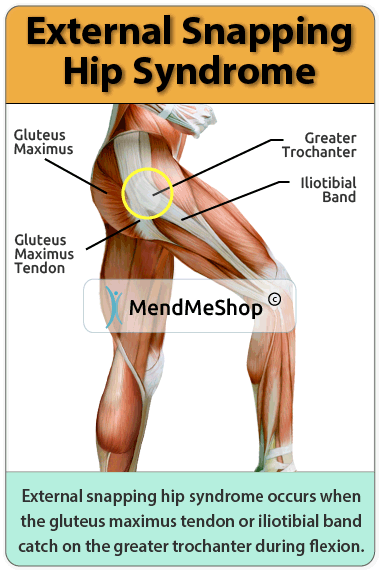

Hip surgery is generally not considered until all conservative treatment options have been exhausted... or there is a complete tear in one or more of the soft tissues in the hip. Unless it is a highly severe or complete tear, doctors, orthopedic specialists and physical therapists will advise that you try at least 6 or more months of conservative therapy with no sign of improvement before surgery will even be considered.
Some conservative treatment methods recommended include:

If you are not at the surgery stage and your physician has opted to treat your injury with conservative treatment options, then you will find that many of our customers have had great success treating themselves with the powerful conservative treatment products such as the Back/Hip TShellz Wrap. When used as directed, it is our opinion that the TShellz Wrap® is a crucial part of a conservative treatment protocol - a protocol that can increase your chances of recovering from damaged soft tissue in the hip. If surgical intervention is required, talk with your physician about using these same products for post-surgery recovery as you will find them to be highly effective for reducing post surgery inflammation, enhancing range of motion and minimizing scar tissue growth (which is a common problem in nearly any case of significant surgery).
Surgery may be necessary if you have exhausted all forms conservative treatments, resting, cold therapy, physical therapy - and, you still find yourself in pain and have limited use of your hip for daily activities. You and your doctor may decide to move forward and have you undergo surgery. This will trigger the next chapter of your hip recovery journey. Your post surgery rehabilitation efforts will have an important impact on how soon you can return to living and enjoying your normal daily life.
As with any surgical procedure, there are risks. Risks for hip surgery include, but are not limited to:
The surgery that your surgeon will recommend for you will depend on the level of your pain and the type of injury to the hip and the amount of damage from your physical exams, x-rays and MRI results.
With acute (recent) tearing, the separation in your tendon / muscle is likely to be very minimal. If you have an acute tear you may qualify for less invasive surgery (such as a arthroscopic, open surgery or an mini-open procedure). Surgeons will always choose a shorter, less invasive procedure if it is possible to do so. Most surgeons know that a less complicated procedure will have less trauma to the soft tissue and a much quicker rate of recovery after the surgery.
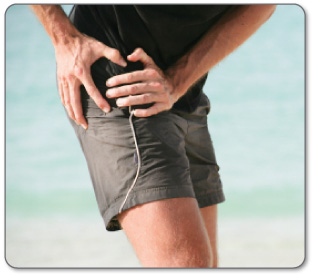
If you have suffered a complete rupture of the tendon/muscle from the bone it is important to have the tissue reattached. One week after a tendon or muscle has ruptured, the ends of the tissue begin to fill in with scar tissue as part of the healing process. As we mentioned before - the added scar tissue increases the natural length of the tissue and may negatively affects your ability to do normal activities.
If scar tissue is present then a more complicated procedure may be needed to clean out the presence of any scar tissue for optimal healing after the surgery. The tissue that has ruptured may need to be retrieved from inside your other tissue back to the original attachment point. This may require your surgeon may have to make a large incision in your skin to retrieve the tissue.
An injury that is 4 to 6 weeks old is considered a chronic rupture. When you have a chronic rupture the tissue tears continue to separate further from their ends increasing the gap in the tendon or weak point in the muscle. A chronic rupture requires a more difficult, drastic surgery and a lengthier recovery period.
As with any surgery there are risks to every procedure depending on a lot of factors, including your age, the severity of your injury and your level of health going into the procedure. It is always best to discuss all possible risks and complications with your doctor, orthopaedic specialist and/or surgeon before the procedure. It's important to be aware of the risks you may face with any procedure intended to fix or relieve pain from your hip injury.
It is always highly recommended that anyone considering surgery always have a clear understanding of the risks as well as the benefits of elective surgery. In addition, one should be aware of the success rate of the particular surgery in question, combined with the post-surgical recommendations that will typically have an impact on your chances of success. Your surgeon should provide a treatment plan to help you regain normal use of your hip as soon as possible.
The surgery to repair a soft tissue injury will usually involve one or more of the following surgical goals:
Open surgery is traditional surgery that has existed in one form or other since the time of early man. Over the last couple centuries and especially in the last 30 years, the risk of negative complications from open surgery have dropped dramatically... although some tail risk persists - mostly dealing with risks from anaesthesia, infection and surgical error (ie. nicking a nerve). Typically, open surgery is only used when there is a large amount of damage that cannot adequately be repaired using arthroscopic surgery. Open surgery is used:
Upon undergoing an Open Surgery, one long incision(s) may made in the area of your injury.
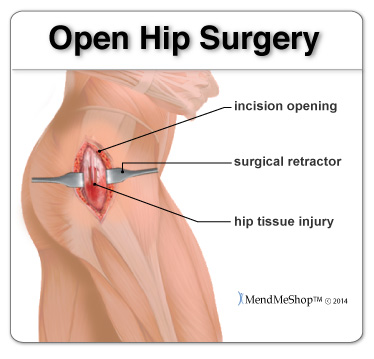
An open incision this large provides enough room for the surgeon to prepare damaged soft tissue for proper repair - whether it be stitching a tissue tear together, debridement, grafting or even bone removal/replacement. A small screw/anchor is used to reattach a tendon back to bone in cases of complete rupture and surgeons will often use a strong nylon or polyester material to bring the edges of tendon or ligament tears back together.
For muscle related damage, a surgeon will often use a strong nylon or polyester material to bring the edges of your torn muscle together. The surgeon will typically use a locking-loop or three-loop pulley pattern to prevent the muscle tissue from gapping. This also provides the muscle with the 'tension' needed to ensure the muscle heals with stronger fibers. (source: US National of Library of Medicine - PubMed.gov)
Non-absorbable sutures ensure that a stitched repair is as strong as possible though there is recent evidence that absorbable sutures may lead to lower risk of wound breakdown. Either way, the surgeon will use his/her considerable skill and knowledge in choosing the best options for your particular case.
An open procedure with precise suturing improves overall strength of your tendons & muscles during the recovery process, making it less likely to re-rupture in the future.
This surgical technique is done during open tendon surgery. To perform a debulking or debridement the surgeon will cut away any damaged/inflamed tissue and scrape down any calcium deposits (bone spurs) that have grown on bone. Scar tissue may be removed from the tendon fibers, tendon sheath surrounding the tissue or from both surfaces.
Debulking or debridement of the tendon or muscle is used as a last resort, if all methods of conservative therapy have been exhausted, in chronic conditions.
Hip arthroscopy can be a minimally invasive surgical procedure that is used to diagnose and/or treat hip conditions. If a doctor is unable to make a diagnosis following a physical exam, x-ray, and/or MRI, an arthroscopy may be performed to get a better look inside the hip joint so a diagnosis can be made.
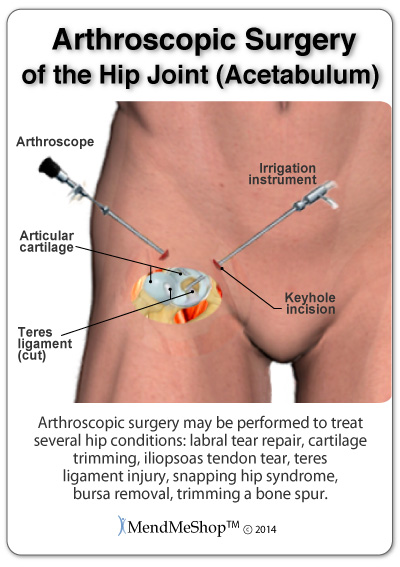
Depending on the severity and type of injury and the age and activity level of the patient, hip arthroscopic surgery may be required for repair if nonsurgical treatments have not shown improvement in pain, range of motion and other symptoms.
A hip arthroscopy is usually performed with the patient under general anaesthetic. During surgery, tiny incisions (1/4" - 1/3") are made to insert the surgical instruments and a small arthroscopic camera that provides an internal view of the location of the surgery.
Arthroscopic surgery is also used to treat knees, elbows and pretty much any other joint... however, the hip is a deeper joint and it can be difficult to insert the instruments and camera at the proper location. As a result, the hip joint may be distracted (opened up) by traction so space is created and the instruments can be used without damaging the labrum, cartilage and other soft tissue.
It is important to understand that surgery may not give you 100% functionality of your hip, but you should be able to eventually return to most if not all of your pre-injury activities. Surgical procedures these days are often performed with very successful results. What truly makes a difference is your commitment to a doctor recommended rehabilitation program after surgery as there is always a possibility of re-injury after a surgical procedure if you are trying to do too much too soon.
If you have undergone surgery on your hip injury then your physician will quickly get you on the path to rehabilitation. Now, the aggressiveness of your rehabilitation efforts and your injuries ability to heal will depend on a variety of factors including (but not limited to):
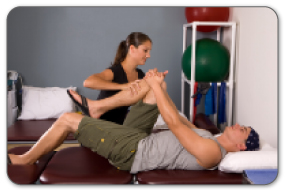
No two rehabilitation plans are alike - The less invasive your surgery is,
the quicker your road to recovery will be.
Proper post-surgery rehabilitation is very important, perhaps even more important than the surgery itself. Most patients can leave the hospital the same day using crutches or a cane. You will be required to follow up with your surgeon and a physical therapist and they will advise you on your recovery.
The goal of a rehabilitation plan is to manage pain and swelling while improving function, strength, and range of motion. Ultimately, you will regain strength in your hip and return to full activity. You will most likely spend a lot of time with a physical therapist after your surgery, but as your healing progresses, emphasis will be placed on your personal at home treatment. The success of your rehabilitation will depend on your dedication to working with your doctor and physical therapist while also managing your recovery on a daily basis at home.
Regardless of what type of surgery you've had (or even if you don't need surgery) your home recovery routine can be improved by controlling initial and ongoing pain/swelling, and increasing blood flow to soft tissue in the area so you can achieve long-term, positive results. This can easily be done by incorporating the use of a Cold Compress or Ice Pack and a Back/Hip TShellz Wrap® into your routine. Consistent use of conservative treatment tools like these will decrease your time spent in recovery. Speak to your doctor, surgeon or physical therapist about incorporating TShellz Wrap® treatments into your post-operative rehabilitation program to boost your overall recovery process.
Each injury/condition will have different challenges for you after surgery. Your surgeon and/or doctor will provide you with clear direction on how to protect your wound and deal with pain so you can achieve a tolerable level of comfort during your recovery.
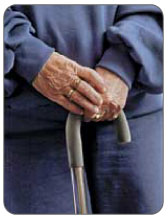
Directly after your surgery has been completed, your hip will go through Step 1 of the healing process by stopping the bleeding that has started because of the incisions and work done inside of your hip. Depending on the type of procedure you have just had, your tissue may be sutured together, reconstructed or removed to fix your underlying condition. In any case, as with any injury to your tissue, the tissue in your hip area will be bleeding again. Depending on the type of injury you have, your surgeon may even stimulate bleeding during your surgery to trigger the healing process.
Typically your body will have begun to stop the bleeding as soon as your surgeon has completed your surgery. This means that the veins carrying your blood will close off, and your blood will coagulate (condense to seal the bleeding off) in order to reduce the amount of blood loss in your body. Your body knows to do this automatically because blood is so vital to the healing process. Blood is basically the vehicle for oxygen and nutrients that travel directly to the injury in your hip - where these things are needed most.
In order to reduce pain, swelling and inflammation your doctor will prescribe an anti-inflammatory drug to be taken during the first 4 weeks after your surgery, or for however long it is needed, depending on your pain level. Your surgeon will also recommend the use of a Cold Compress or Ice Pack on a frequent basis - multiple times per day - to control your inflammation and reduce your pain.
If you have undergone an arthroscopic surgery, you may have little bleeding/blood loss and your doctor or surgeon will check before you leave to make sure your bleeding at the incisions has stopped. If you have undergone an open surgery, your doctor and/or surgeon will check your incisions periodically over the next few days of your hospital-stay to ensure that your body has stopped the bleeding on its own and also make sure that your incisions are starting to heal.
After your incisions, repaired and/or removed tissue has stopped bleeding; your hip will become tender, swollen, red and hot to the touch - these are all symptoms of inflammation. Step 2 of the healing process is inflammation reduction. At this point you will be home if you have had arthroscopic surgery, or you may still be in the hospital if you have had open surgery. In order to reduce pain, swelling and inflammation your doctor will prescribe an anti-inflammatory drug to be taken during the first week or 2 after your surgery. Your surgeon will also recommend a treatment for dealing with inflammation, like R.I.C.E. (Rest, Ice, Compression, Elevation).
We highly recommend use of a Cold Compress or Ice Pack at this stage for 15 to 20 minutes at a time, several times a day, to control your inflammation and reduce your pain.
Rest at this point is vital to your rehabilitation plan depending on the surgery you have undergone. If you have had arthroscopic surgery with minimal internal wounding from your surgeon, you may be encouraged to start movement early or as soon as possible. Limited movements of the hip/knee will be required in most cases after the surgery. If you have had an invasive open surgery, then you may be encouraged to rest longer at first before starting movement. Depending on your type of surgery, rehabilitation with a physical therapist will begin 2-6 weeks after surgery.
Your doctor or surgeon will advance you to the next Phase of rehabilitation when there is no evidence of inflammation or swelling in your hip. If you have had arthroscopic surgery, your doctor may expect that you are able to move your hip around pain free before moving onto the next Phase of rehabilitation.
After your tissue starts to heal your hip will be in a weakened state and will not be as strong as healthy tissue for some time. This is why you need to be on "re-injury watch" and make the most of your physical therapy appointments and home therapies during your rehabilitation. It would be devastating if overdoing it at any point during the first few months of rehabilitation would send you right back into the operating room.
After the initial healing of your hip surgery (when Step 1 and 2 of the healing process is done), temporary tissue will start to grow around tissue that was damaged during your injury or the surgery. Step 3 is the Growth of Temporary Tissue.
Typically (though not always) approximately 2-6 weeks after surgery, your surgeon will recommend regular physical therapy appointments where you will be encouraged to (1) gain back range of motion (ROM), and (2) increase the stability of your recently repaired hip. Your physical therapy appointments will be 1-3 times per week, and your progression of movement in your hip will be the guide. You will start with the gradual movement of your hip in a free (non-forced) way with little weight or resistance, normally with very few repetitions of activity. Strengthening exercises will slowly increase in difficulty (with more resistance) after your surgery. Your hip will be stiff and painful at first, and simple, easy movements may seem challenging in the beginning. Don't be discouraged, your hard work will pay off in the end!
At about 6 to 12 weeks (depending on your type of surgery) you still need to allow for healing from the surgery. Although you may be feeling much better and your pain is reducing, repaired soft tissue at 4 weeks is typically only 20% healed. At 8 weeks it will be about 40% strong and after 12 weeks the tendon is 60% as strong as normal tendon. The point where the pain decreases yet the tendons and muscles are still weak is a critical point. This is the stage where you need to be very careful about re-injury.
Your physical therapy appointments will be 1-3 times per week, and your progression of movement in your hip will be the guide. At your appointments you will be encouraged to gain back some of your range of motion and increase the stability of your repaired hip. You will start with the gradual movement of your hip in a free (non-forced) way with little weight or resistance, normally with very few repetitions of activity. Your hip will be stiff and painful at first, and simple, easy movements may seem challenging in the beginning. Don't be discouraged, your hard work will pay off in the end!
At Home Stretching/Exercise - Your therapist will encourage you and tell you just how important it is to commit to regular exercise at home as well as in the clinic. You should be doing homes exercises up to 3 times per day. They will give you the exercises and guidance based on your overall hip soreness level and your morning discomfort.
We advise our clients to apply a TShellz Wrap® treatment to help increase blood flow before stretching (or exercise). Apply a TShellz Wrap treatment for approximately 15 to 20 minutes (finishing 15 minutes before exercise) to help increase elasticity and flexibility of your tendons, ligaments and muscles. The increased elasticity will help minimize tissue tears and scar tissue growth (increase ROM and decrease reinjury risk.

Controlling post-exercise swelling and inflammation is crucial during this Phase. Any sign of swelling or inflammation after exercise may be an indication of minor re-injury to your hip or surrounding tissues and muscles. Control your inflammation immediately after exercise with a 15 to 20 minute cold treatment. If you are not careful to treat your swelling or inflammation immediately after exercise you may experience a set-back in your recovery.
Your doctor, surgeon or physical therapist will advance you to the next Phase of rehabilitation when you show measured improvement of range of motion (ROM), strength, stability and flexibility of your hip. The level of improvement will depend on the severity of your injury and the type of surgery you have had. For example, if you have had a relatively simple arthroscopic repair of tissue, you may be expected to move the hip around before moving to Phase 3 of your rehabilitation.
If you have questions, call our office at 1-866-237-9608 (toll free continental US).
After temporary tissue has grown (Step 3 of the healing process), this temporary tissue will go through different stages of conversion into healthy, normal, flexible tissue. This is Step 4 of the healing process (Complete Tissue Re-Growth). Before converting into healthy tissue, temporary tissue will often become tough, dense, fibrous scar tissue. Scar tissue has an unorganized, inflexible tissue structure, which makes it brittle. Scar tissue will provide your injury with more long term fusing power, but will also stick to surrounding healthy tissue in your hip. The growth of this scar tissue is what stiffens your hip and lower back, restricting movement and flexibility.
This Phase of your rehabilitation will focus on an increase in activity level in order to regain full range of motion (ROM) and muscle strength in your hip. Continued exercise and activity will help break up and soften scar tissue.

We generally recommend clients to consider the use of a Back/Hip TShellz Wrap® BEFORE exercise/stretching and the use a Cold Compress or Ice Pack after exercise and activity. This protocol will go a long way to maintaining overall tissue stretchability, reduce re-injury risk, and treat any pain, swelling or inflammation due to overexertion of your leg/ankle. If you are noticing any recurring inflammation, you can continue cold treatments as recommended by your doctor.
Your doctor or physical therapist will advance you to the next Phase of rehabilitation when you have regained full ROM (range of motion) without pain in your hip. You may also have to pass clinical exams or tests of your muscle strength, balance, stability and flexibility in order to be cleared for Phase 4.
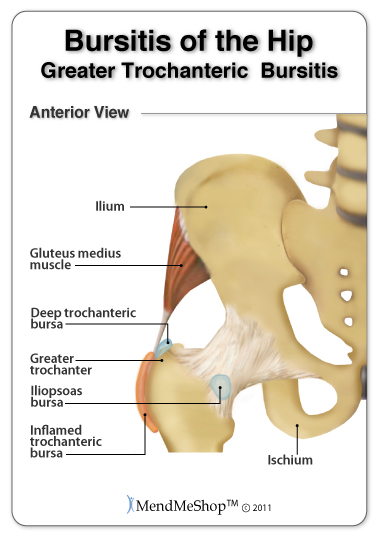
When your overall condition and range of motion has improved your doctor or physical therapist may clear you for a return to work or athletic activity. In many cases, they may recommend that you continue muscle strengthening and stretching instructed during your rehabilitation in order to maintain healthy ROM of your hip. Additional cardiovascular exercise will also be encouraged. If you are an athlete or have a job that requires extensive physical capability, your doctor or physical therapist will likely advise a very gradual return to previous activity.
Scar tissue may plague you for weeks, months and maybe even years after your surgery depending on your level of activity and the amount of conservative therapy you have undergone during your rehabilitation. Scar tissue will be a major problem as scar tissue can easily build up quickly and its hard to get rid of.
Even if you have been cleared to get back to activity, you still must be careful with the activity you take on. You need to keep in mind that your hip won't be back to 100% for some time (recovery rarely reaches 100%) and so continued stretching with the exercises and stretches outlined in the ebooks and treatment with T•Shellz and cold therapy will maintain good health of the hip and significantly reduce your risk of re-injury.
Rehabilitation after your hip surgery is just the beginning of your recovery process. Even after you've had surgery to fix your hip and deal with the build-up of scar tissue, it is improbable that your soft tissue will heal 100%. From this point forward, it is more important than ever to be careful with your hip. It is almost a certainty that your hip will be weaker now, and your risk of re-injury is just that much higher because of this.
As with any type of surgery, the surgeon will weigh the costs versus the benefits of performing surgery on a particular case. Scar tissue is something that cannot be avoided during surgery, and the surgeon will determine if the probable outcome will be better even after the scar tissue from surgery is considered.

Scar tissue is something that will be in your injury before and after your surgery. The growth of scar tissue is what causes stiffening in the hip, restricting movement and flexibility. Scar Tissue is something that can't be avoided during surgery. Your surgeon will determine if the anticipated outcome from surgery will be successful even with the build-up of scar tissue that will happen after the procedure. Overall, the surgeon may be able to remove a lot of the initial buildup of scar tissue around the injury and in doing so, achieve a positive outcome from the surgery.
Unfortunately, scar tissue may plague you for weeks, months and maybe even years after your surgery depending on the type of surgery, your level of activity and the amount of conservative treatments you have done during your rehabilitation.
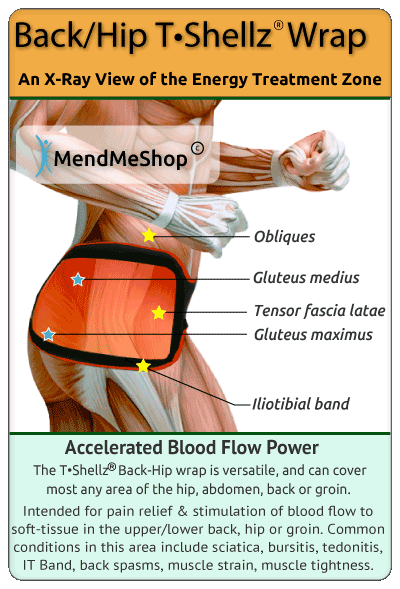
It's simple to manage long-term health of your hip with conservative treatment methods that can be used in the comfort of your own home. If you're looking for an all-natural form of pain management and a Localized Enhanced Circulatory Response mechanism for long-lasting relief, seriously consider the benefits of incorporating the Back/Hip TShellz Wrap into your treatment plan.
A Cold Compress or Ice Pack can help you to decrease post-operative pain and swelling while also managing any pain from occasional inflammatory flare-ups (re-injury). Consistent treatment with a Cold Compress or Ice Pack will reduce inflammation and gently numb nerve endings in your tissue for effective pain relief after injury flare ups.
During your last few stages of rehabilitation, while you're undergoing physical therapy and focusing on improvements to your range of motion, it's important to maintain healthy blood flow in your hip. Strong and healthy tissues need a solid local circulatory system, and this is exactly what our TShellz Wraps are made for.
Reduced blood flow slows down your recovery process. If your tissue remains in this condition, you'll always be at risk of re-injury that will severely set back your healing progress.
Use TShellz Wraps regularly to prevent re-injury and keep your muscles, tendons and ligaments elastic and flexible. Healthy blood flow is vital to the healing process after hip surgery. Your blood flow is what brings oxygen, nutrients and energy (things needed to heal) into your damaged tissue. Blood Flow promotes tissue re-growth, strengthening the delicate work your surgeon has done.
Regular treatments with a Back/Hip TShellz Wrap will provide an enhancement to localized bloodflow which, in most cases, will help increase your body's natural healing rate. An enhanced healing rate will help decrease time spent in recovery.
Tendons, ligaments, muscle and other soft tissue in the hip are all meant to be soft and flexible, ready to work and move extreme forces in everyday activities. When I say extreme force, I mean try to imagine the amount of force that your hip handles, even when you are just walking, let alone running, jumping or climbing stairs. As mentioned on the home page, a stumble during a walk can put peak forces of over 800% of your body weight on your hip!
Scar tissue grows in damaged tissue when it tries to heal; little tiny band-aids that overlap each other to bind tiny tissue tears together. With this added scar tissue, muscles & tendons & ligaments become rigid, less flexible and unable to handle the forces that it once could. If you're suffering with scar tissue now you may feel the effects with stiffness, tightness, weakness and tiredness in your hip.
Scar tissue can form fast to bring together the edges of a tear, but working fast doesn't mean that the job's done right. When scar tissue forms it doesn't come together as neatly as regular (healthy) tissue would. Scar tissue fibers will lay down over top of your tear in a cluttered, messy and jumbled up way.
On-going issues with scar tissue can result in soft tissue tears and increase chances of strain to nearby tendons or ligaments (as they are now handling higher forces due to overcompensation).
Scar tissue is one of the MAIN reasons why a chronic hip injury has not healed and your Range of Motion (ROM) is reduced from what it once was.
Scar tissue will form fast to deal with a soft tissue hip injury, and this scar tissue will attach to EVERYTHING in the area, including the surrounding healthy tissue as well. This can result in a fusing together of the soft tissue in your hip that shouldn't be fused together, and this will cause extreme pain when you move your hip - it is literally ripping scar tissue. This is why physical therapy is often painful - the therapist stretches the joint, forcing the scar tissue bonds to break so you can regain your range of motion.
Scar tissue is a major problem especially when it comes to a hip injury - causing your injury to become chronic, and taking months or even YEARS to completely heal!
You can quickly minimize scar tissue growth and reduce risk of re-injury to your hip muscles/tendons/ligaments by increasing blood flow to that area and increasing the elasticity of soft tissue in the area. Treating yourself with the Back/Hip TShellz Wrap is the easiest and most effective way to accelerate your recovery, increase soft tissue elasticity and deal with stubborn scar tissue.
When applied before activity or work, the TShellz Wrap will also relax and lengthen your soft tissue to help improve your range of motion and prevent atrophy (tissue wasting & shortening) of your injured hip.
Overall, continued treatment with a TShellz Wrap will maintain good health in your soft tissue and significantly reduce your risk of re-injury.
If you want to heal quickly, you need to keep your blood moving and that's where Circulatory Boost, comes in.
What is Circulatory Boost? It's a substantial increase in the flow of blood to soft tissue in the hip without the need to exercise your already damaged tissue.
Have you seen what happens when you add water to a flower wilted from drought? In essence, your injured hip is much like a "wilted" flower; your body wants to heal its injury, but needs lots of nutrients to do it. Blood supports and facilitates new life by delivering healing nutrients and oxygen that are vital to your tissue. In addition, the blood carries away toxins and waste cleaning the area and healing it faster. Without a good supply of blood, your injury simply won't heal properly.
When using a TShellz Wrap® your injured hip is constantly being fed with healing, nutritious, oxygen and energy filled blood. Blood flow is how your body heals itself.
In order to get maximum blood flow to your hip, you need to help your body stimulate blood flow. A TShellz Wrap® is the fast, easy and pain-free way to increase blood flow, which will invigorate your body's natural healing process. In our view, it should be a key component in a conservative treatment home recovery plan.
If your doctor thinks you might be able to avoid surgery by using conservative treatments, you can join our many customers who have had great success treating themselves with the powerful treatment products we offer through MendMyHip.
Iliotibial Band Syndrome, Snapping Hip, Bursitis of the Hip, Tendinitis or muscle spasms of the hip, impingements and other soft tissue hip injuries are not uncommon - it can happen to anyone. Right now, there are thousands of doctors and physical therapists dealing with patients that require a solution to heal their injury as fast as possible. Maybe they are just patients that are unwilling to just take pain pills, lay in bed and wait or perhaps they are patients with extensive access to medical care with a great insurance plan. Even fortunate patients such as this have greatly benefited from boosting their PT and medical treatments with home therapies using the products we have recommended after getting approval from their doctor or PT.
Regardless of who you are or your reasons, if you want to be proactive about dealing with your hip condition and minimizing the negative impact it will have on your lifestyle, talk with your physician about incorporating the use of a Back/Hip TShellz Wrap® in your conservative home recovery plan. We have many happy customers that have recovered from their injuries faster than even they had hoped for, and significantly reduced their pain during treatment and through the healing process.
Click HERE to Go To Our Online Store We take all major credit cards and Paypal. If you are on your mobile phone, Click to Call Our Office (toll free continental NA).
Living with pain is never easy as it affects your entire lifestyle. Living with pain during or after an intensive surgery and lengthy rehabilitation period can be even harder! What is more important than taking your best shot at trying to heal your hip before signing up for surgery?
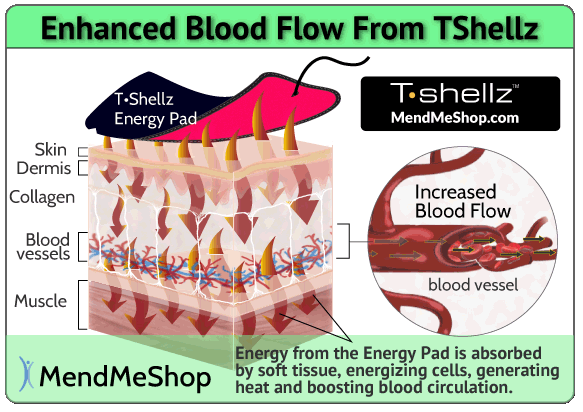
Doctors and Surgeons are always improving the technologies used in surgery, and results from surgery now are much more positive than they were in the past. However, all surgeries introduce scar tissue, and recovery from hip surgery is often disappointing. If you do wind up getting surgery, know that rehabilitation at-home while attending regular physical therapy or doctor appointments is vital for your overall recovery. It is especially vital to the hip, knee, ankle and shoulder areas, as they consistently handle extreme forces (body weight). Consistent exercise and conservative treatment on a daily basis during your rehabilitation while working with your doctor, surgeon or physical therapist is key - and this is why you should seriously consider maximizing your recovery by using the Back/Hip TShellz Wrap® at home once you are approved for physical therapy.
MendMyHip.com stands out in this regard as our goal is to help you keep your hip healthy for the long-term in a cost effective manner. This might mean a hip recovery at home without the need for surgery. If you couldn't avoid surgery, then we believe our tools can also help get you back on your feet after surgery.
We strongly believe that we can help you, and we have thousands of happy clients to back this claim. You are welcome to try our products for a 60 day period.. If you are committed to following the treatments outlined in the product instructions we are very confident that our TShellz Wraps will aid you immensely. If you do not receive the benefits that countless of our other customers have experienced from our products, call us for instructions to mail the product back and we will provide you with a full product refund.
Our online shop accepts Visa & Mastercard as well as a Paypal Payment option.
We also encourage your to Call Our Office at 1-866-237-9608 (toll free continental NA) where we can answer any questions you have and/or take your order via phone. Consistent use of home conservative treatments will help keep your hip joint as healthy as possible. Having a healthy hip joint will minimize your risk of a degrading hip injury that may eventually turn chronic. Some common chronic hip conditions are arthritis, osteoarthritis, tendinosis and bursitis (a common condition immediately following surgery due to irritation during the procedure). Following surgery, continued use of these therapies will typically result in a faster recovery with greater Range of Motion and an overall healthier hip.
Ask your physical therapist about the TShellz Wrap® and if it is a suitable treatment option for your recovery! As with all medical devices, make sure your physician is aware of any treatment plan you decide to take. MendMyHip advisors do not work on commission, so be assured you will only receive fair and objective information.
Living with pain is never easy and we encourage you to call us with any questions you have related to your knee injury. We will do our best to help.
Product Advisors are available 9:00 am to 5:00 pm Eastern Standard Time Monday to Friday.
I want to learn more about Hip Surgery & Post-Surgery Recovery
I want to learn more about Circulation Boost
I want to learn more about Ice & Heat: Which Is Better For The Hip?
I want to learn more about Trigger Points in the Hip
I want to learn more about Hip Surgery: Do I Need It?
During your recovery, you will probably have to modify and/or eliminate any activities that cause pain or discomfort at the location of your soft tissue injury until the pain and inflammation settle. The more diligent you are with your treatment and rehabilitation, the faster you will see successful results!
Please be aware that this information is neither intended nor implied to be a substitute for professional medical advice. CALL YOUR HEALTHCARE PROVIDER IMMEDIATELY IF YOU THINK YOU MAY HAVE A MEDICAL EMERGENCY. Always seek the advice of your physician or other qualified health provider before using any of our outstanding products to make sure they are right for you and your condition or if you have any questions regarding a medical condition. Always see your doctor for a proper diagnosis as there are often many injuries and conditions (some very serious) that could be the cause of your pain.
© 2025 In.Genu Design Group, Inc. Contact Us